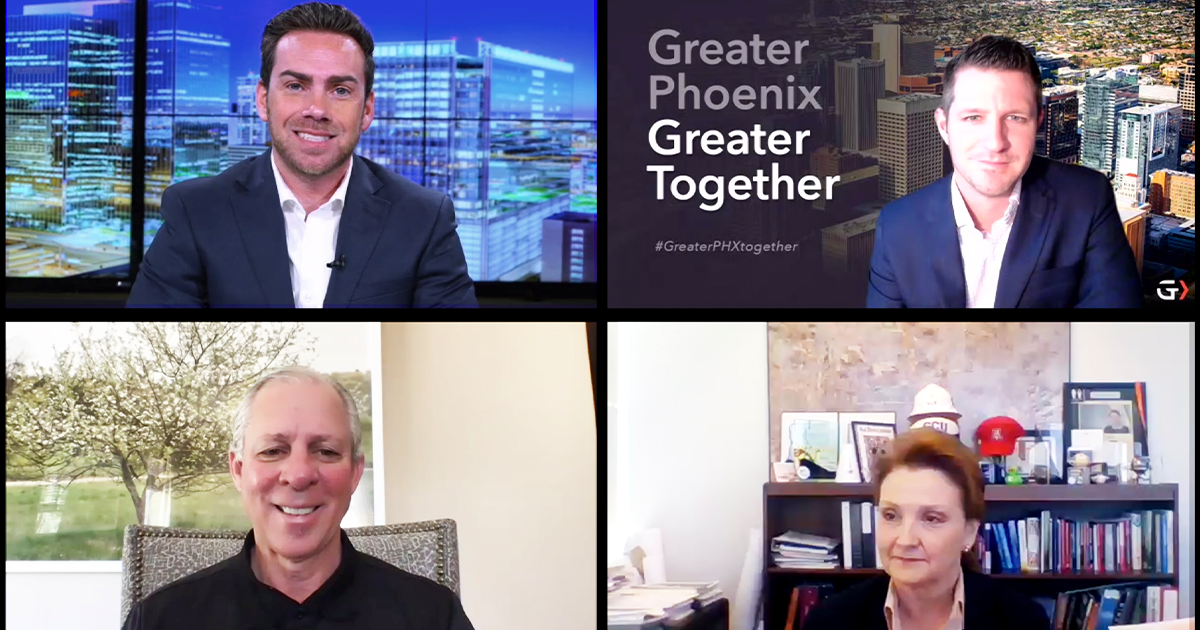

Regional Report: Status of Greater Phoenix
Published: 04/27/2020
Updated: 05/13/2020
A GPEC Virtual Series
The gravity and scale of COVID-19’s impact on the economy isn’t comparable to The Resolution Trust, 9/11 or the Great Recession. It’s unlike anything the world has ever seen. Even with President Trump signing the $484 billion aid package on Friday, delivering a $310 billion infusion to the Paycheck Protection Program (PPP) and $50 billion for the Small Business Administration’s (SBA) emergency disaster lending, apprehension remains resolute. Uncertainty has locked its iron fist around capital markets, industry and individuals, and the vast economic and societal effects of the virus are forcing business leaders in Greater Phoenix to rewrite the route to recovery with minimal guiding light.
“There’s no playbook for this one. This isn’t one we’ve seen before where it hits so quickly, and so deeply and broadly,” said Christine Mackay, Community and Economic Development director with the City of Phoenix. “I know it’s not giving people comfort. We’re working diligently through all of this…trying to come up with solutions to help as many of our businesses, particularly small businesses, through this.”
Mackay spoke during a webinar Friday hosted by the Greater Phoenix Economic Council (GPEC). The latest installment in GPEC’s virtual series, ‘Regional Report,’ was a matter-of-fact status update with insights provided by Mackay, GPEC President & CEO, Chris Camacho, and Dr. Robert Robbins, president of The University of Arizona.
“We’re in the midst of a very significant decision-making time for our country, and certainly for our state,” said Camacho.
Referencing the next round of funding pumped into federal programs to support small businesses, he notes Arizona can do much better when the SBA resume accepting PPP loan applications on Monday, April 27 at 10:30 a.m. EDT.
Nearly 20,000 Arizona small businesses received PPP loans in round one, totaling $4.8 billion. At first glance, those figures appear substantial, but only a fraction of eligible small businesses received funding.
- 17 loans for every 100 eligible small businesses in the state, ranking Arizona 46th in the country
- $4.2 million approved dollars for every 100 small businesses, which ranked the state 44th
Federal dollars will be competitive with bank queues stacked from the previous round and new applicants approaching the end of their capital runway. On average, small businesses have 27 days of liquidity on-hand. GPEC is working tirelessly to stand up resources, consolidate information and insights into the application process, and recently launched a live chat feature on its website to answer questions.
Despite GPEC’s and partners’ concerted efforts, Camacho doesn’t know if the new funding will be enough to cover everybody.
“Say that through the second phase that one-third of our businesses do get covered by the PPP, that still leaves two-thirds of our businesses under-resourced,” he said.
Mackay’s outlook is just as stark.
“I would estimate that somewhere between 20 and 25 percent of the region’s small businesses won’t be standing when this thing is over,” she said. “It’s going to be deep, and it’s going to be brutal. We’re working to help those businesses any way we can to see the light at the end of the tunnel and hang on just a little bit longer.”
The pandemic’s assault across sectors is relentless and the reductions Mackay mentions are evident through restaurant industry data Camacho highlighted. Sales are down nearly $30 million and job losses sit between 70-90 percent. Typically, Greater Phoenix restaurants register $36.7 million in sales and $13.4 million in payroll each day.
“We have to get our small businesses filing for these federal dollars,” said Camacho. “Once they’re gone, they’re gone. This is a massive cash injection at stake, and I believe it absolutely plays into our ability to recover from the COVID-19 impacts.”
The region’s economic viability is contingent on the health and safety of the workforce, and Dr. Robert Robbins, president of The University of Arizona, shared the advancements his institution is making to combat the virus.
“I knew early on that testing was going to be really important and if we didn’t have the test kits, we couldn’t do the tests,” he said. “It was going to be important to get a serological test to be able to determine whether someone was either actively infected now or had the infection with COVID-19 before looking at antibodies.”
The University of Arizona will conduct antibody testing for all of its students, faculty and staff, which they developed in one of their basic labs.
Dr. Robbins says testing will provide data about which people have the infection and who has antibodies in order to translate those fundamental discoveries into products that make the world a better place.
“We’re rolling that out in partnership with the [governor] to test all frontline healthcare providers in the state of Arizona,” he says. “In this initial phase we’re testing about 350,000 people with our family at the U of A and…my goal would be to test everyone in the state of Arizona.”
Camacho agreed testing is critical and closed with a topic many aren’t talking about – enterprise companies – and the significant contributions their making in the fight against the virus, and their role in the short and long-term recovery of Greater Phoenix’s economy.
“I don’t want to lose sight of how important it is for us to recruit and help those kinds of companies expand. We’re just seeing the vulnerabilities of small business today, which is the near-term crisis, but longer-term we need both of those segments to be really strong,” he says. “I see the resilience of this community coming together and that’s why I’m so optimistic about our future. We will get back on track, and might take more time than we all want, but it’ll happen and we’re going to keep working towards that.”